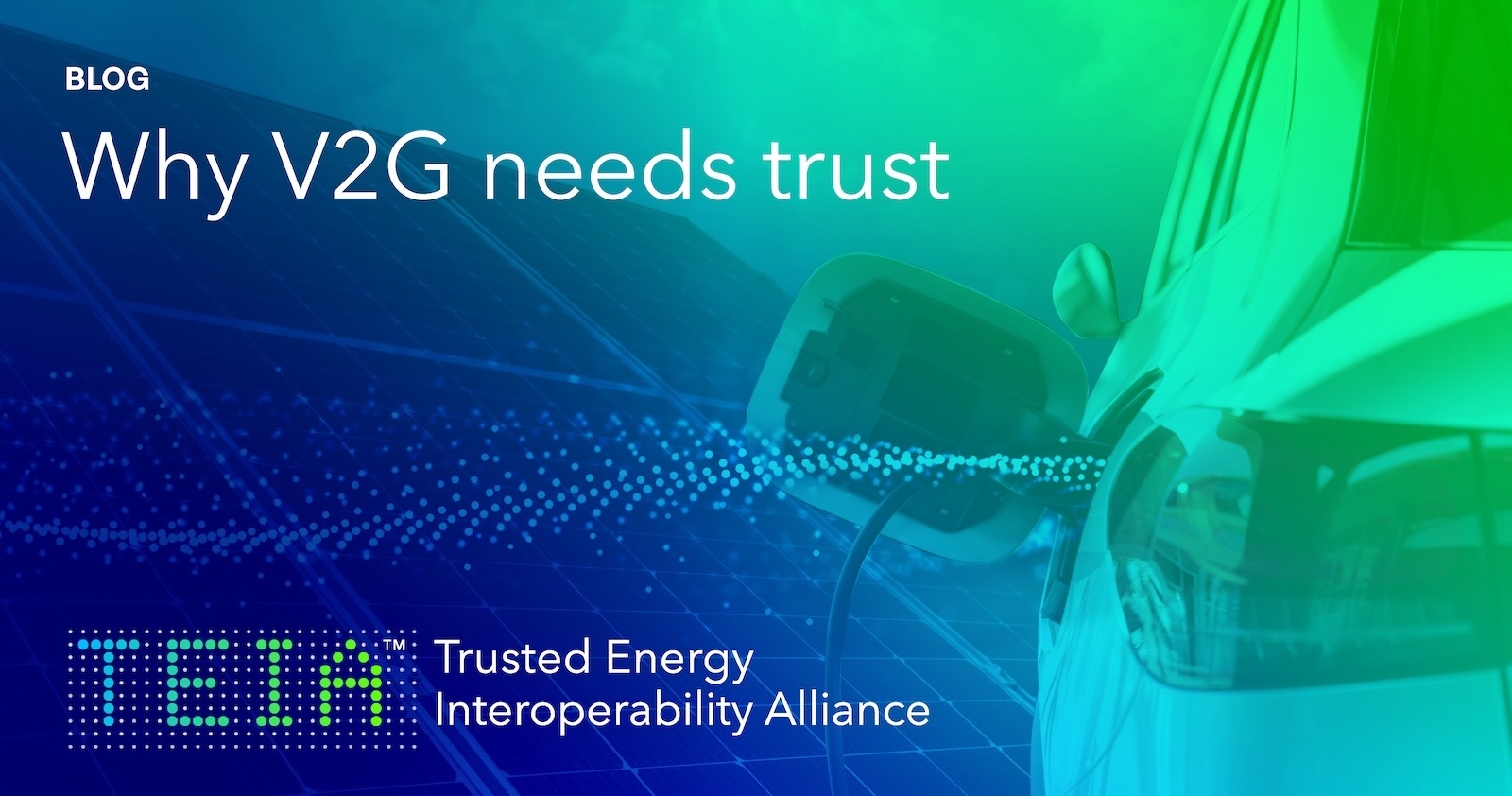When I tell people that my world involves energy markets with billions of dollars of volatility during a single day—they often look surprised. But that’s the reality I’ve been working in for over a decade, first at Origin Energy in Australia and now at Intertrust. And it’s exactly why flexibility isn’t just a nice-to-have in our energy system—it’s becoming the DNA of how we operate.
Recently, I had the opportunity to speak at a CharIN focus group alongside my colleague Bryan Crotaz from GivEnergy about the Trusted Energy Interoperability Alliance (TEIA) and why we believe vehicle-to-grid (V2G) technology represents both one of the biggest opportunities and challenge facing our industry today.
The perfect storm: why everything is changing
For years—decades, really—we’ve operated in a fairly predictable environment. Supply was controllable, demand was relatively stable, and the biggest challenge was simply matching the two. That world is disappearing fast.
On the supply side, decarbonization efforts are driving massive renewable energy deployment. Wind and solar are fantastic, but they’re also intermittent. When the wind doesn’t blow and the sun doesn’t shine, we need a backup plan. When they’re both producing at full capacity, we need somewhere to put all that energy.
Over on the demand side, we’re seeing the first substantial increases in electricity consumption in years. Electric vehicles are a huge part of this, powering our clean energy-driven world. And crucially, this new demand isn’t just bigger—it’s variable in ways we’ve never had to manage before.
So, we have variable supply trying to meet variable demand. For energy companies, this isn’t a technical curiosity—it’s a fundamental challenge that requires us to rethink how we operate.
Why energy companies are actually waiting for V2G
While consumers might not be waiting for V2G, energy companies are anxiously anticipating it because of its transformative potential.
Electric vehicles represent a double-edged sword. On one hand, they’re adding massive new load to the grid, often in unpredictable patterns as people charge when they get home from work or travel. On the other hand, if we can harness V2G effectively, we’re looking at distributed storage assets that we don’t have to build or install.
The numbers are staggering. A typical EV battery has 50-100 kWh of capacity. Scale that across millions of vehicles, and storage capacity that dwarfs anything we could build with traditional utility-scale batteries. Plus, these assets are mobile—they can provide services where they’re needed most, when they’re needed most.
But here’s the catch: to make this work at scale we have to solve a fundamental problem–trust. Can we really trust millions of devices to safely and reliably interact with the grid and people’s homes?
The trust problem we can’t ignore
When Bryan Crotaz joined me for the presentation, he laid out some scenarios that are deeply concerning for the industry. Imagine someone creating a fake flexibility provider, paying consumers to sign up, then instructing all their devices to discharge or charge simultaneously. We could be talking about tens of gigawatts hitting the grid in seconds—roughly ten times the load that triggered the Spanish grid collapse a few months ago.
Or consider a more sophisticated attack: a botnet masquerading as thousands of batteries, sending fake telemetry to make it appear they’re charging and discharging. The grid operators, seeing all this fake supply, would turn off real generation to compensate. Then suddenly, all that fake supply disappears, and you’ve got a massive shortage that could collapse the entire system.
These aren’t far-fetched scenarios. They’re logical extensions of the vulnerabilities we create when we scale up distributed energy resources without proper security foundations.
Why TEIA is taking a different approach
This is exactly why we formed the Trusted Energy Interoperability Alliance. TEIA isn’t trying to replace existing standards like OCPP or create yet another protocol that everyone has to learn. Instead, we’re focused on one thing: establishing a universal trust model that can work with any standard, any device, any application.
Our approach is built on a few core principles:
It’s open and non-proprietary. If we’re going to solve industry-wide problems, the solution has to be something everyone can adopt and contribute to.
It’s extensible. We’re starting with trust, but the framework needs to grow and adapt as the industry evolves.
It’s complementary. Rather than replacing existing standards, we want to provide the security foundation that makes all of them more robust.
The technical architecture includes some elegant solutions to practical problems. For instance, the pre-shared AES keys eliminate the need for complex handshaking protocols every time a device connects. When you’re dealing with millions of distributed devices that need to check in regularly, reducing connection overhead from five messages each way to a single secure transmission can dramatically reduce cloud infrastructure costs.
But perhaps more importantly, the journaling feature creates an immutable record of every transaction. If there’s ever a dispute about whether energy was actually supplied or whether control commands were properly sent and received, the journal can serve as legal evidence of what actually happened, second by second.
This is the way: collaboration over competition
During the Q&A, someone raised an important question about vertical integration versus interoperability. It’s a fair concern—if you’re a manufacturer who also wants to be an aggregator, why would you support open standards that let competitors access your devices?
The answer is simple: the market will decide which business models succeed, but the technology should support all of them. TEIA’s security model allows device manufacturers to maintain complete control over their assets if that’s their chosen business model. You can restrict devices to only communicate with your own systems and not grant permission for other parties to create new security associations.
Consider the case of a heat pump manufacturer who insisted its proprietary protocol was a unique selling proposition: the USP isn’t your protocol—it’s your physics. For battery companies, it’s your chemistry. For Tesla, it’s the beautiful integration and packaging. The protocol that moves data between devices and servers? Customers never see that. It’s infrastructure.
We’re all trying to send the same basic information: power, energy, time, and some maintenance data. Why should we each spend 20 engineers and two years building proprietary solutions when we could each contribute one engineer for two years and get a better result that benefits everyone?
Making it real
At GivEnergy, Bryan’s team is already moving their internal processes to become TEIA compliant over the next six months. They’re working on mapping TEIA onto OCPP to demonstrate how both standards can work together without conflict, giving users the best of both worlds.
This is exactly the kind of practical progress we need. TEIA isn’t some theoretical future standard—it’s a working solution that companies are implementing today.
But we need more participants. Every company working with DERs faces the same fundamental challenge: how do you trust that the device you’re talking to is actually what it claims to be, and how do you ensure the messages you’re sending are secure and verifiable?
Whether you’re planning to run a closed, vertically integrated system or an open, interoperable platform, you still need to solve the trust problem. Rather than each of us reinventing the wheel, let’s collaborate on the foundation and compete on what really matters—the value we deliver to customers and the grid.
About Cameron Briggs
Cameron Briggs serves as the Chairman of the Trusted Energy Interoperability Alliance (TEIA). He is also Senior Vice President and Head of Energy Systems at Intertrust Technologies Corporation. Previously GM and Head of Future Energy at Origin Energy, he led innovation strategy and global energy startup engagement. Cameron holds a PhD in Applied Physics and an MBA from the University of Queensland.




